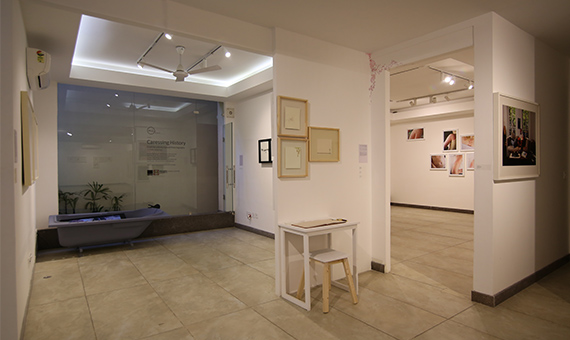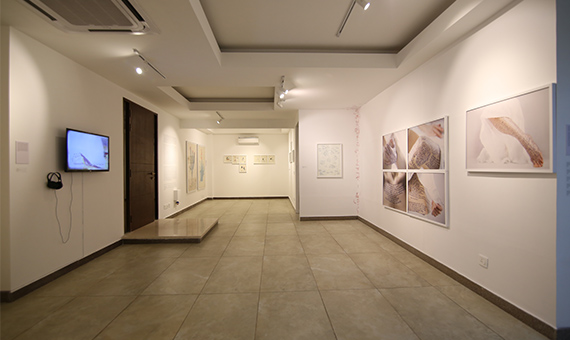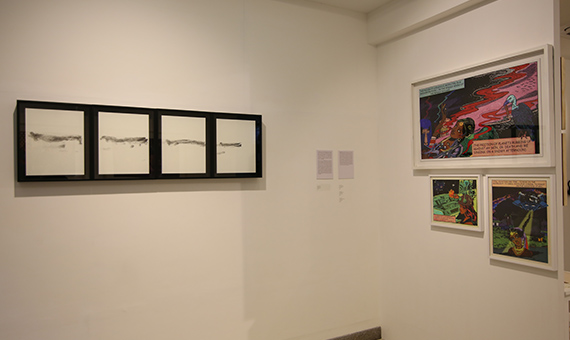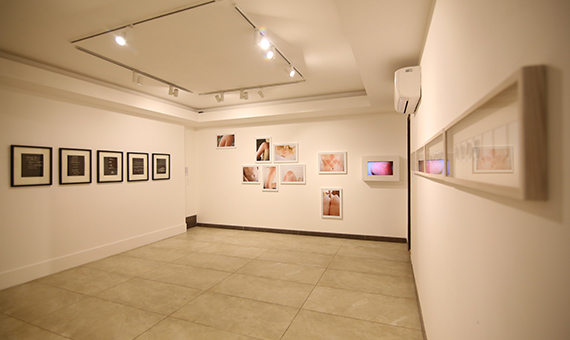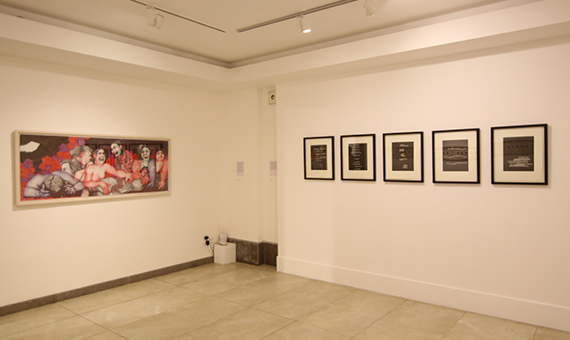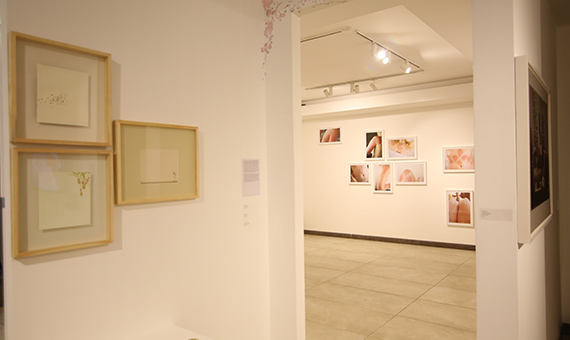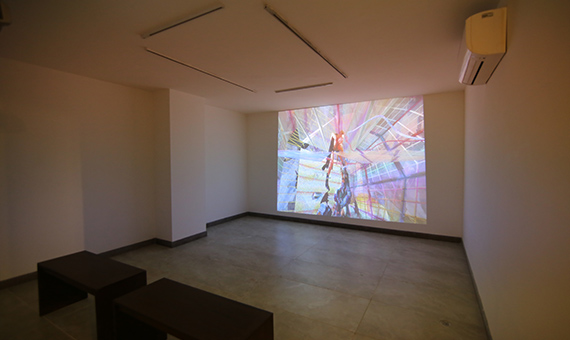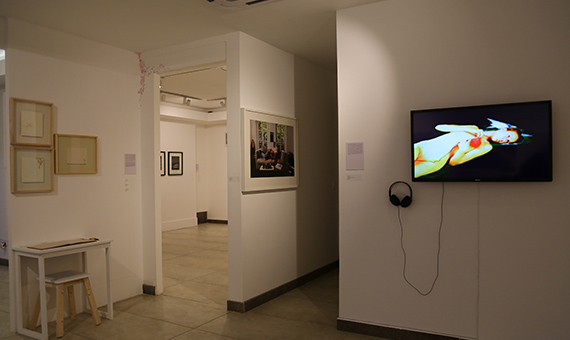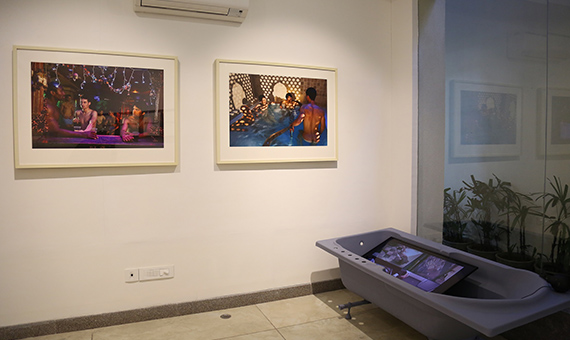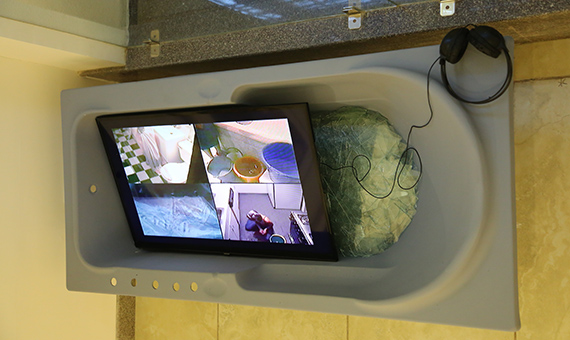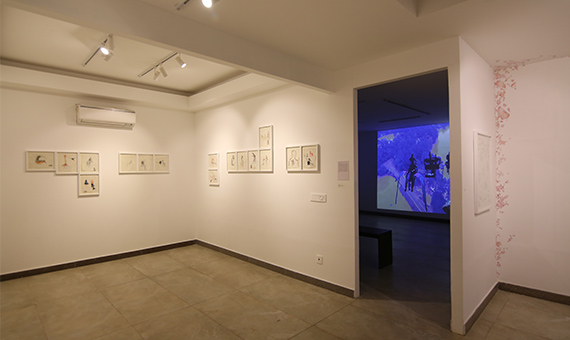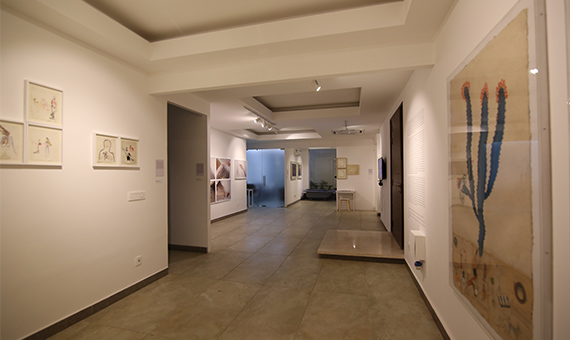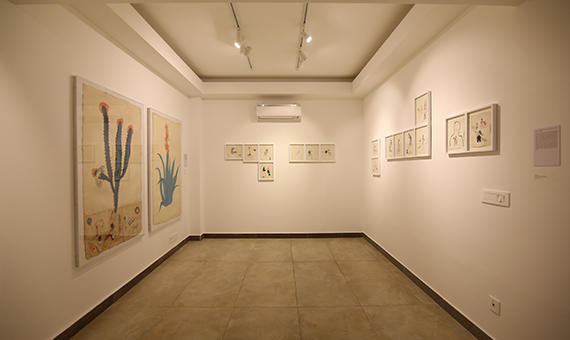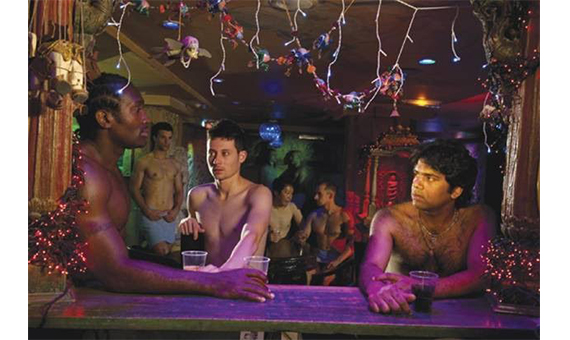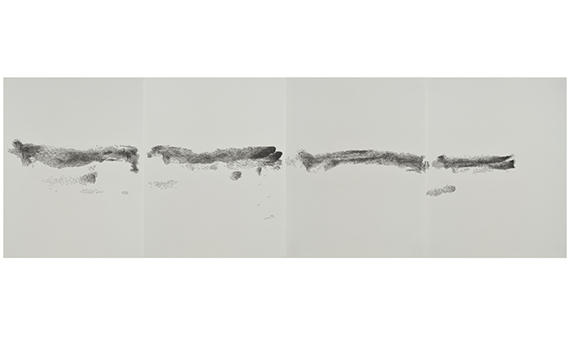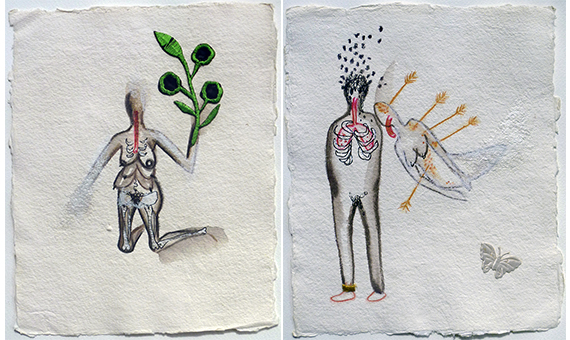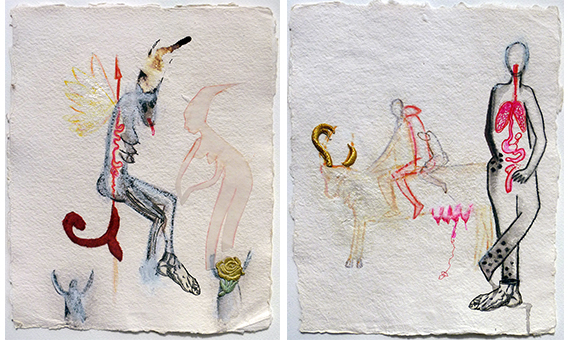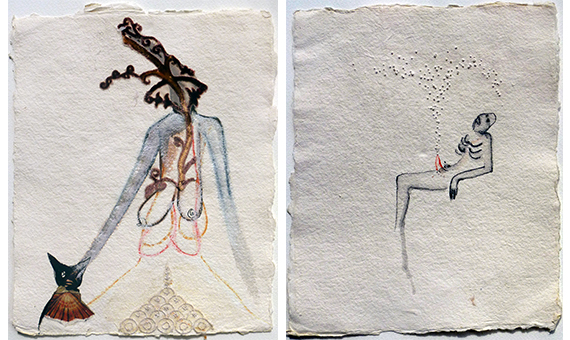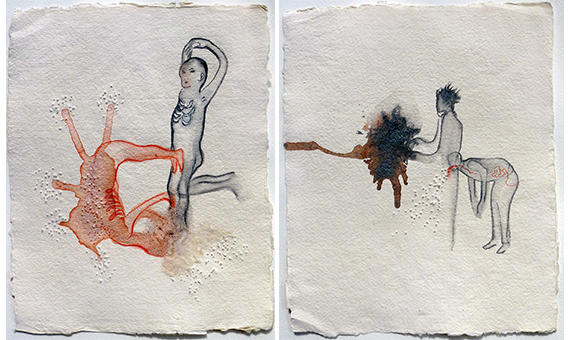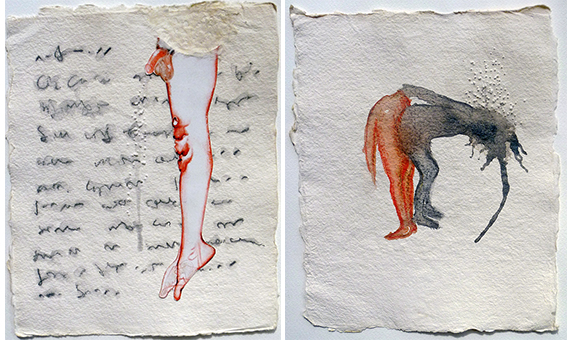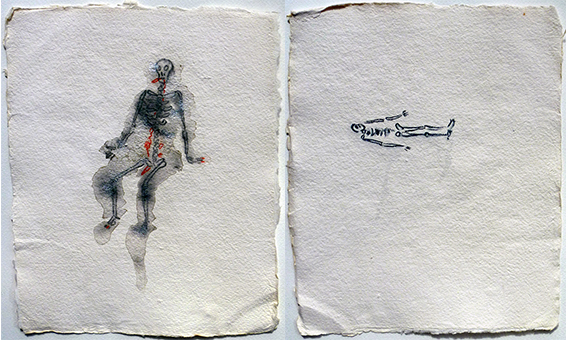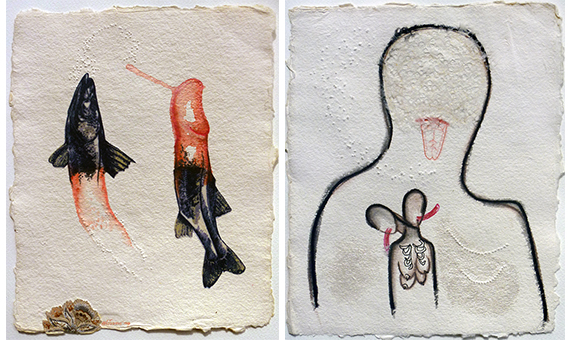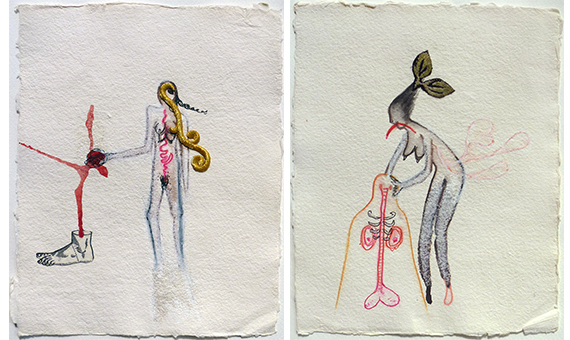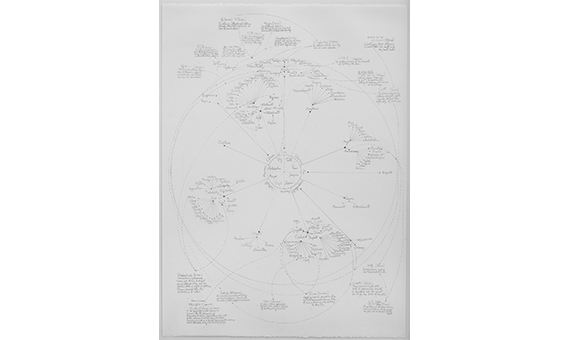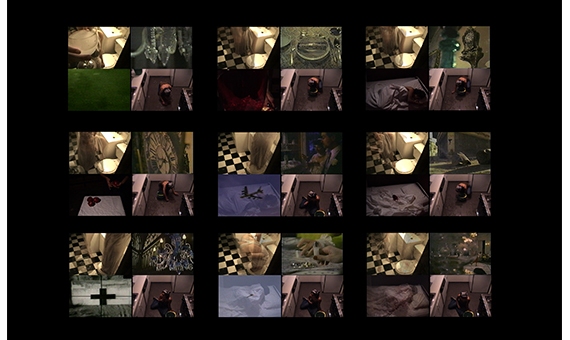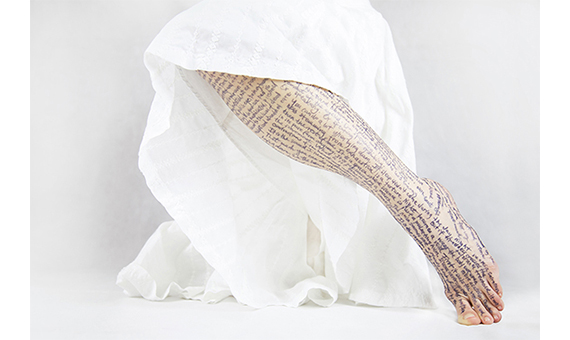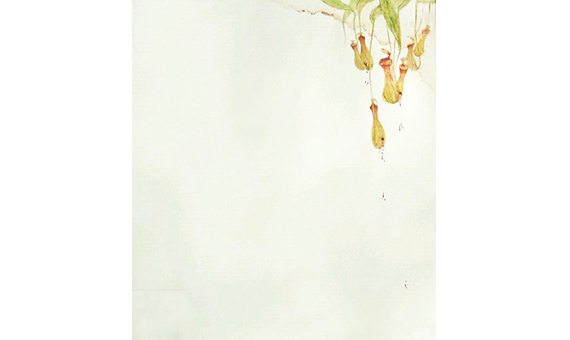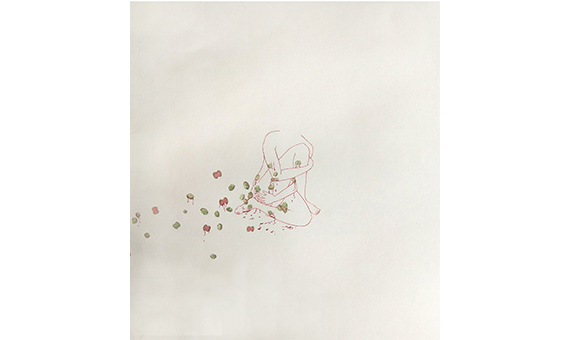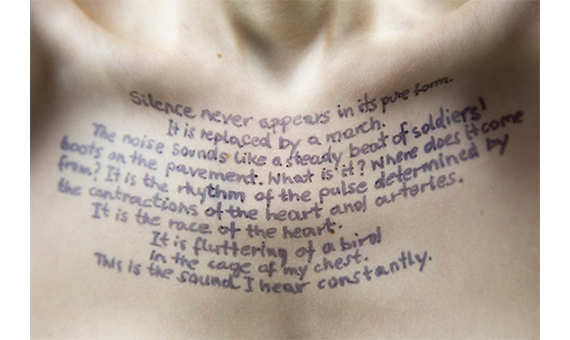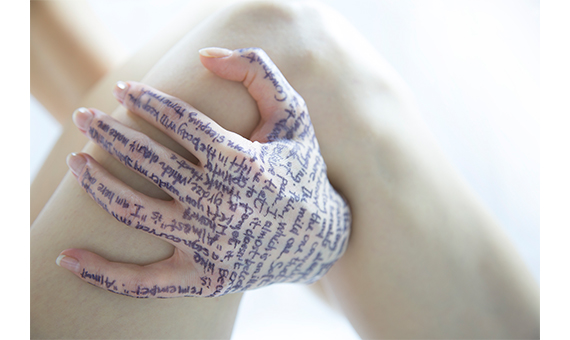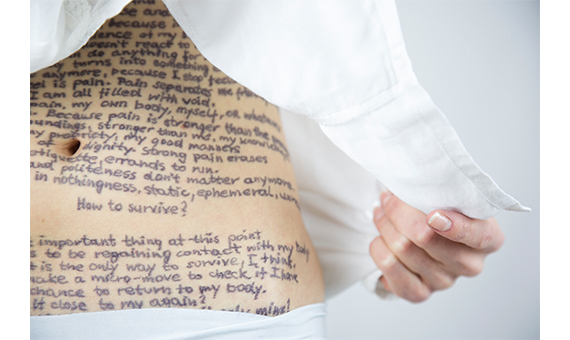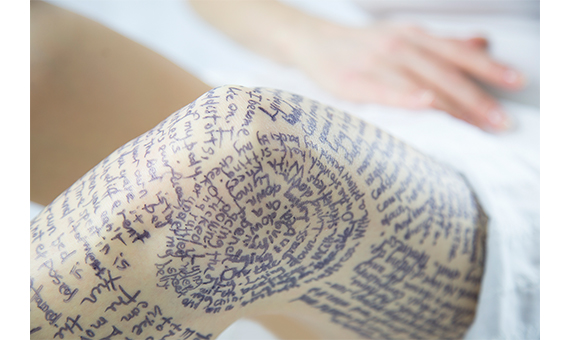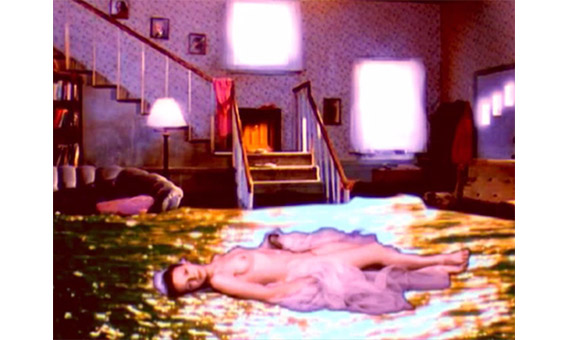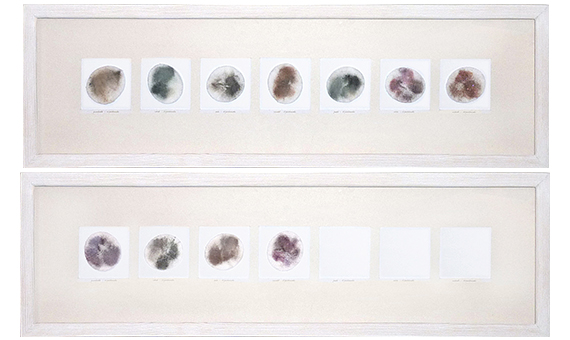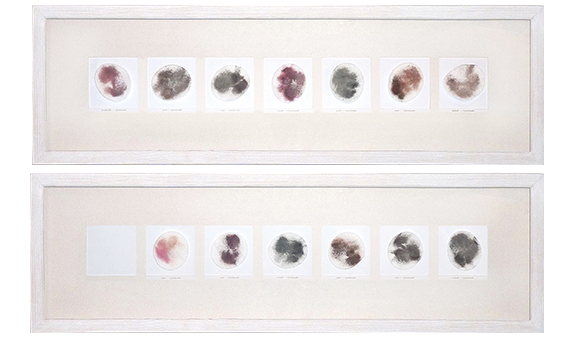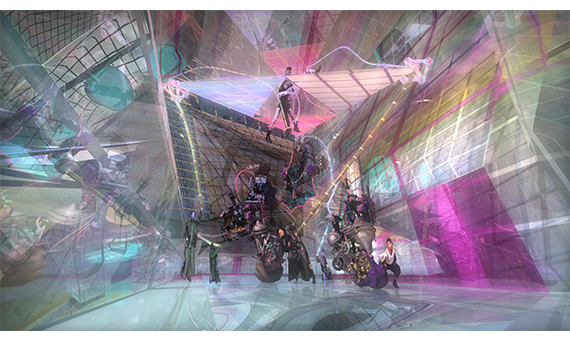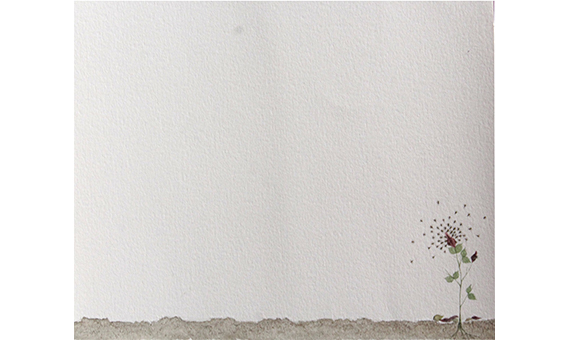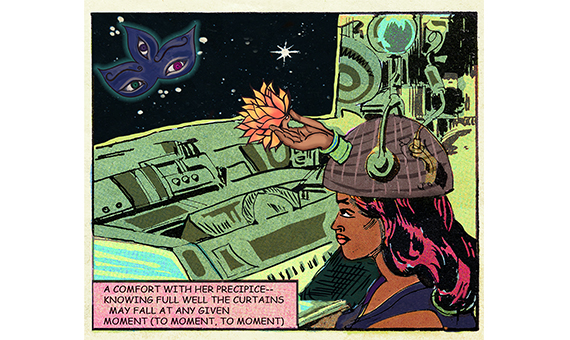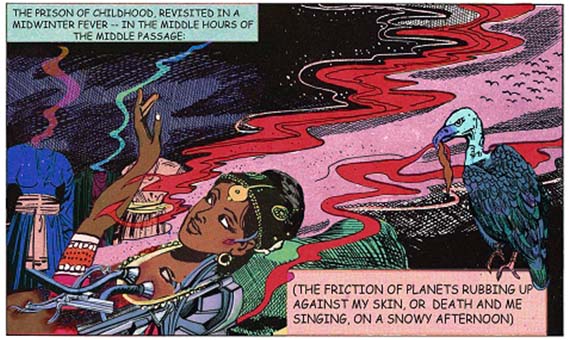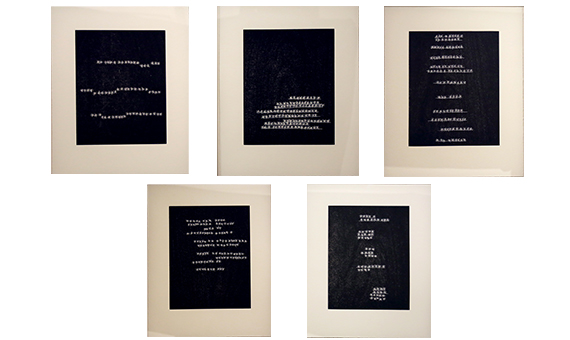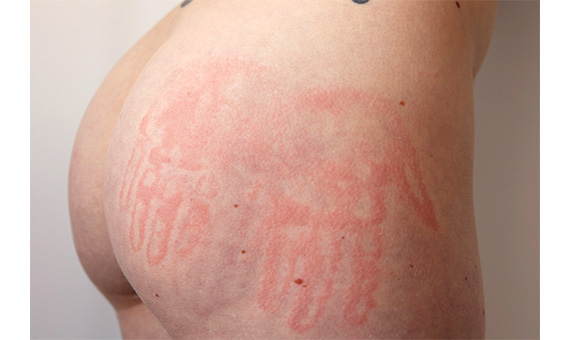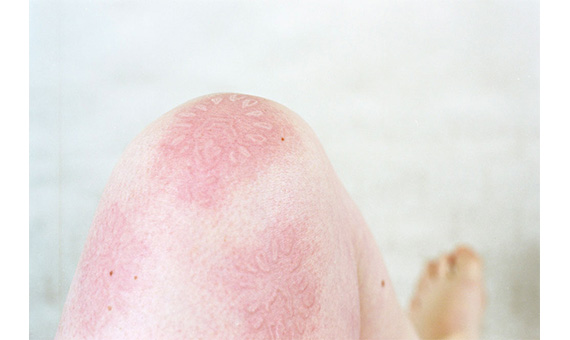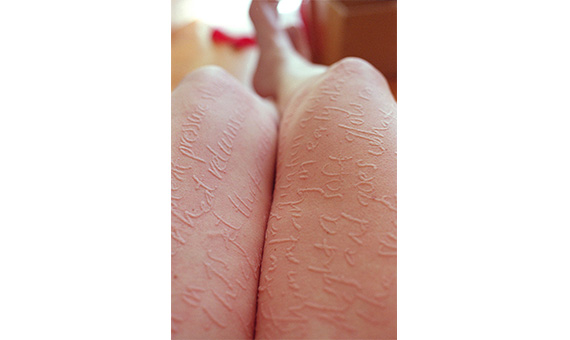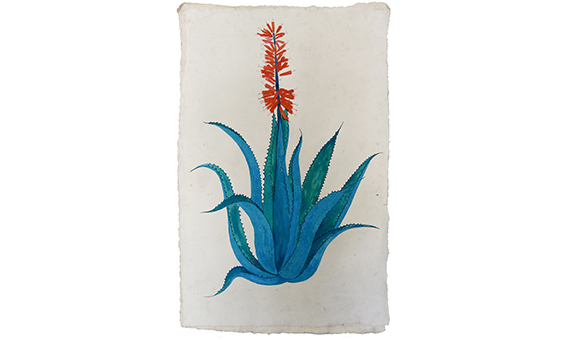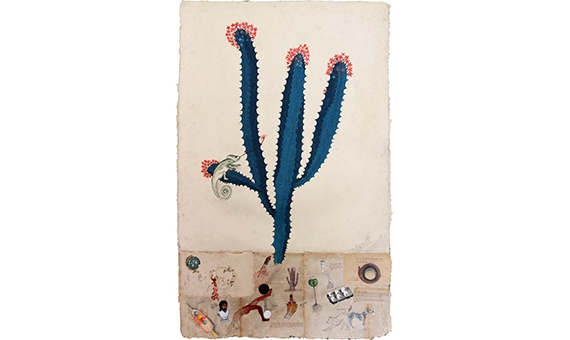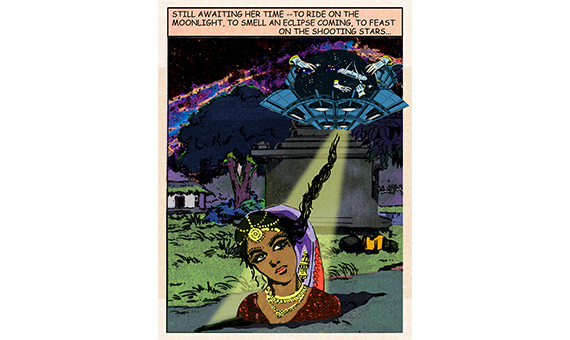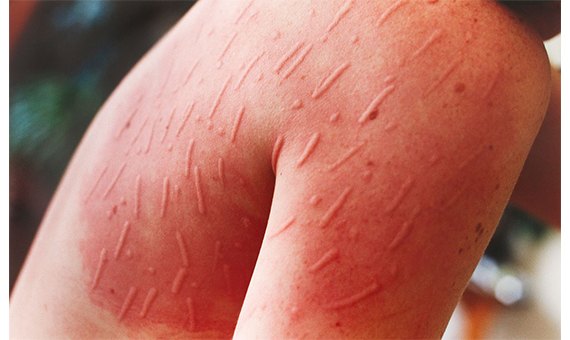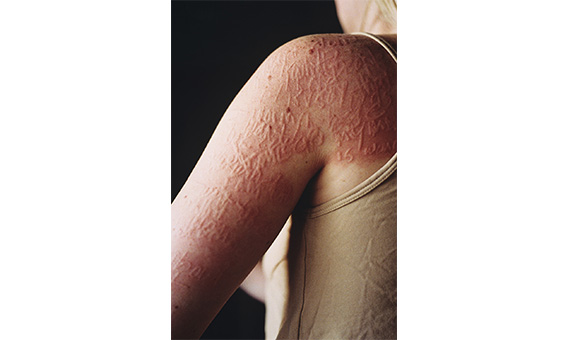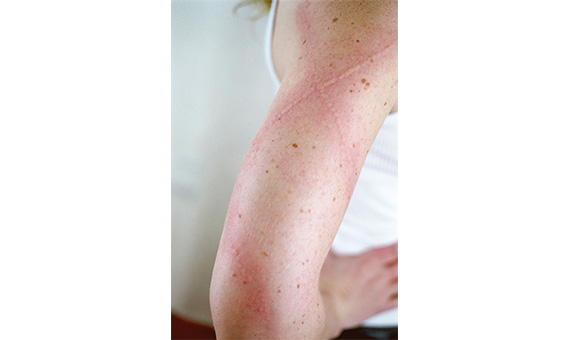About the Artists
Ariana Page Russell (USA)
Ariana Page Russell is a visual artist and artist coach. She creates images that explore the skin as a document of human experience, using her own hypersensitive flesh to illustrate the ways we expose, express, adorn and articulate ourselves.
Russell lives and works in Los Angeles, California. She has exhibited internationally, including the Royal Hibernian Academy, Dublin; New York University, New York City; Massachusetts College of Art and Design, Boston; Platform Gallery, Seattle; Town Hall Gallery, Australia; the Luminato Festival, Toronto; and Museo de Arte Contemporáneo, Bolivia. Her work has appeared in Art in America, the Huffington Post, Wired, The Atlantic, VISION Magazine: China, and the monograph ‘Dressing’ published by Decode Books. She was featured on ABC News 20/20 and was a recent participant in the Sexto Encuentro Mundial de Arte Corporal in Caracas, Venezuela. She received her MFA from the University of Washington, Seattle in 2005.
BR Shailesh (India)
Born in 1986, Shailesh B.R. received a bachelor’s degree in fine arts, specialising in painting, from the Chamarajendran Academy of Visual Arts, Mysore, and has a post-graduate diploma from the Faculty of Fine Arts, MSU, Baroda. His practice revolves around the nature of processes – of philosophical thought, art and rituals, expressed through a visual vocabulary that makes the viewer reimagine the purpose and function of routine objects. His works are playful reconfigurations of philosophical thought through mechanical means. His drawings (which unapologetically reject any grammatical precision) question the staunch formalism associated with art and use the premise of honest artistic wonder instead to explore how errors can be made in how he sees, perceives and defends his ideas.
Chitra Ganesh (USA)
Chitra Ganesh (b. 1975 Brooklyn, New York, USA) received a BA in Art-Semiotics and Comparative Literature from Brown University, Providence, RI in 1996. She attended the Skowhegan School of Painting and Sculpture in 2001 and received her MFA in Visual Arts from Columbia University, NY in 2002. She lives and works in Brooklyn, NY, USA.
Across a twenty-year practice, Chitra Ganesh has developed an expansive body of work rooted in drawing and painting, which has evolved to encompass animations, wall drawings, collages, computer generated imagery, video, and sculpture. Through studies in literature, semiotics, social theory, science fiction, and historical and mythic texts, Ganesh attempts to reconcile representations of femininity, sexuality, and power absent from the artistic and literary canons. She often draws on Hindu and Buddhist iconography and South Asian forms such as Kalighat and Madhubani, and is currently negotiating her relationship to these images with the rise of right wing fundamentalism in India.
Ester Fleckner (Denmark, Germany)
The work of Ester Fleckner is analogue and hands-on driven. It derives from explorations of language and materials in ways that make marks of a work process, errors and the repetitive labour of trying again into central part of the works. Moving within notions of queerness, Fleckner is inspired by the value of chaotic knowledge, the unfinished, failure, and experiences of displacement. Fleckner's practise has materialised in series of woodcut prints, sculptural and installational work, texts, collages and performative reading formats.
Éva Magyarósi (Hungary)
Eva Magyarosi is a mid-career established artist, who originates from Hungary, like other celebrated artists such as Júlia Vécsei, József Csató, Tamás Kaszás, Andres Kertesz, and Szilárd Juhász. Eva Magyarosi was born in 1981.
Eva Magyarosi grew up during the 1990s and was influenced by the artistic atmosphere of the time. In the United Kingdom, a group of artists known as the YBAs, or Young British Artists, dominated the artistic culture of the decade. They were a loosely affiliated and diverse group, connected generally by their age and nationality. A number of the members had attended the Royal College of Art and Goldsmiths in London, and were favoured by Charles Saatchi, the ‘super collector’ of art at the time. The most famous member of the group is arguably Damien Hirst, and other members included Chris Ofili, Tracey Emin, Marc Quinn, Gavin Turk, Sarah Lucas and Sam Taylor-Johnson (née Sam Taylor-Wood). Through their use of shock tactics and sensationalism, the YBAs garnered a controversial reputation image which was further fuelled by their use of throwaway materials, wild lifestyles and an attitude that was at the same time rebellious and enterprising. The group dominated the British art scene in the 1990s and their group show ‘Sensation’ is now viewed as legendary.
Iwona Demko (Poland)
Iwona is a vaginatist artist, sculptor, feminist, artistic missionary and artivist.
Born on 7 August 1974 in Sanok, she obtained her diploma in 2001 at the Academy of Fine Arts in Krakow at the Sculpture Department. Since 2008, she has worked at her Alma Mater featuring as a ’’pink sheep” of the Department. In 2012 she defended her PhD based on her dissertation ‘’Vaginatism” and the sculpture ‘’The Chapel of Vagina”. In 2016 she received her post-doctoral degree based on a piece originating from her friendship with two women working as sex workers and an exhibition they created together. Against the warnings coming from her own artistic and academic circles, she deliberately produces work that may be classified as feminist art. Iwona curated a few feminist exhibitions, such as ‘’Krzataczki” [Bustlers], ‘’HERstoria sztuki” [Art HerStory], ‘’Gastronomki” [Caterers]. Recently, she is immersed in her research on the history of women’s struggle for the right to study at Krakow’s Academy.
Jacolby Satterwhite (USA)
Jacolby Satterwhite (born 1986 in Columbia, South Carolina) is an American contemporary artist who works with video, performance, 3D animation, fibers, drawing and printmaking, currently based in New York City, NY.
His work often utilizes his mother's schematic drawings/inventions of ordinary objects influenced by consumer culture, medicine, fashion, Surrealism, mathematics, sex, philosophy, astrology, and matrilineal concerns.
Khushbu Patel (India)
Khushbu Patel is an Indian artist. Her interdisciplinary art practice spans diverse mediums in various scales presented in form of installations (site specific/site responding), photography, performative photography, videos, drawings, and performance. Her interest revolves around the concept and idea of change, which she had tried to show through the process, subjects, concepts and her choice of medium. Her process has always been bound up in time. The time duration from beginning a piece of work till the end is what really holds the importance in her work, and brings us much closer to it. Things that arouse her interest have to do with the life of any living or inanimate object, the temporal quality of earthly existence and the inevitability of change and decomposition, the effect of time, and its various marks- prime sources of fascination in her work.
Patel’s recent body of work is mainly about looking through the lens of abjection –talking about that which inherently disturbs conventional identity and cultural concepts. For her, this includes the notion of beauty, the impermanence of appearances and the permanence of essences. Her concern is also about questioning history: the way people have been defining beauty, the stereotypes in society, objectification of bodies and political objection
Malgorzata Dawidek (Poland, UK)
Her artistic and academic interests encompass the visual arts, literature and certain medical matters.
The conflict between the condition of the human body and discursive language is the core of her practice, which addresses aspects of corporeality as a continuous narration, a text ‘in process’ which I describe as bodygraphy.
Combining performance art, photography, video, textual drawing and installations as the main media for her works, she both searches for visual representations of the body in crisis, of physical and mental illness and of isolation, and analyses issues relating to awareness, the boundaries and possibilities of language, the body’s vulnerability, pain, loss and exclusion, and to the inexpressibility of these states verbally.
The crucial question of her practice concerns how to express the experience of the body in crisis through art? How to break away from the Ill=Other cliche and bypass flaunting illness as an attraction or emotional blackmail?
In her art process, she investigates forms of visual essay and performative narrative as a medical, socially engaged and artistic strategy that goes beyond the strictly private and stereotypical, ill-person–doctor circle and contributes to social and medical knowledge about invisible diseases, vulnerability, identity and the abilities of the ‘non-normative’ human body. Creating a space for potentiality and positive categories in the field of representation of boundary experiences, she develops her own concepts of affective art practice.
Mariam Ghani (USA)
Mariam Ghani is an artist, writer, and filmmaker. Her work looks at places and moments where social, political, and cultural structures take on visible forms. Long-term collaborations include the experimental archive Index of the Disappeared, with Chitra Ganesh, and the video series Performed Places, with choreographer Erin Kelly and composer Qasim Naqvi. Solo and collaborative exhibitions include the Indianapolis Museum of Art (2017), the Queens Museum of Art (2016), the Saint Louis Art Museum (2015), the Rogaland Kunstsenter (2014), and the Gatchina Museum (2013). Notable group exhibitions include the Asian Art Biennial (2017), the Dhaka Art Summit (2016), the Guggenheim Museum (2016), the Secession in Vienna (2015), the CCCB in Barcelona (2014), dOCUMENTA 13 in Kassel and Kabul (2012), the WKV in Stuttgart (2012, 2010), and the Sharjah Biennial (2011, 2009). Notable screenings include the Rotterdam Film Festival, CPH:DOX, the Liverpool Biennial, the National Gallery in DC, and the Met Breuer and MoMA in New York. Her recent texts have been published in Foreign Policy, Ibraaz, Triple Canopy, and the readers Assuming Boycott, Critical Writing Ensembles, Dissonant Archives, Utopian Pulse, and Social Medium: Artists Writing 2000-2015. Ghani also teaches and lectures internationally and has received a number of awards, grants and fellowships, most recently from Art Matters, Creative Capital, Yale Law and the Center for Constitutional Rights.
Mithu Sen (India)
Mithu Sen performs conceptual and interactive multi-format byproducts which include drawing, poetry, moving images, sculptures, installations, sound, and others. Her practice manifests human interactions, employing the medium of life to actualize her art production. She constantly (un)defines concepts and their functioning with regard to acceptable modes of interactions, questioning pre-codified hierarchies that define the social performance of roles, politics of tabooed identity that marks the other, and the plethora of constructs that actualize human existence as a reality. Through radical hospitality, lingual anarchy, counter capitalism, untaboo sexuality, and unmonolith identity; the artist persistently explores the void of in betweenness, where (un)constructs dwell, waiting to be (un)realised.
Mithu Sen is a an earth based (New Delhi, India) artist/poet who studied painting at Kala Bhavan, Visva Bharati, Santiniketan, India, and Glasgow School of Art, UK. Mithu Sen plays. She messes. She creates. Her practice revolves around creating situations of impossible possibility. She lets strangeness and strangers in, radically, hospitably. In doing this she questions the boundaries of hospitality; identifies them, embodies them, inhabits them- and then refutes and ignores them. Breaking them apart from within.
Mithu Sen dislikes the word “medium.” She 'life's. Sen’s practice centers her constant need to be expressive in limitless ways; in ways that are counter to limits; that deny them. Her work involves the use of blank space-- her detailed drawings highlight the otherwise unseen, and parody or dismiss what our eyes are used to catching. Sen has accessories/tools that extend and include her body-mind. She draws, creates videos, and sculptures. She installs. She performs. Her performances have elements of sound and movement and writing. She poets. She poet. She lives. Her practice converses and responds; and is therefore constantly adapting itself; it shapeshifts from one medium to another. People are sparked to reflect on several realms and layers of thinking and questioning in her work, including:
(Untaboo) sexuality, (unmonolith) identity, Radical hospitality (guest-host-hospitality-tolerance) Counter capitalism, and lingual anarchy Her journey critiques subtle hierarchical codes and hegemony;
Mithu’s work lives in the spaces between when Humanity becomes a minority (sexual, political, regional, emotional, lingual...).
Neerja Kothari (India)
Neerja Kothari (b.1980, Kolkata) is an artist currently living and working from Kolkata, India. She holds a B.Com from Calcutta University, India and an MFA from the School of the Museum of Fine Arts, Boston/Tufts University, USA. She has been awarded fellowships at the Ucross Foundation, Helene Wurlitzer Foundation, the Corporation of Yaddo, MacDowell Colony, Virginia Center for the Creative Arts, Vermont Studio Center and the La Napoule Art Foundation.
Her work has also been published in the New American Paintings (NE#110) journal and the Manifest International Drawing Annual INDA8
Neerja’s work deals with the investigation of the absurd. It’s an attempt at trying to quantify an unquantifiable experience. This is inspired by the time spent in physical rehabilitation recovering from motor sensory neuropathy. Every movement that the brain forgot had to be relearned. The process was slow and fragmented. Every movement was broken down to its smallest bit. And then bit by bit the bigger ideas were formulated. The work then emerges as an investigation of larger existential questions.
Derived from multiple instances and memories, the work becomes an accumulation of time, labor, process, memories, marks and numbers. Each factor playing a part in its own investigation: Like a clock may think it quantifies time, or a metronome might want to quantify music. Often easily read as a case of obsessive compulsive, Neerja likes to emphasize the absolute necessity of the process. The brain forgot things learned in the first score years and she had to retune the muscle memory to a very instructional rhythm. The distilled-down instructional methodology in the work then reiterates that process of re building and re tuning and re learning.
Increasingly, now she finds that the absurdity and futility of the work is really important. As is the notion of being trapped in other’s oddities and other’s absurdities. These other’s oddities that also made her. Therefore the work is at a point where a lived experience is being translated, explored and represented. There is a struggle to find that mode of representation, a search for a new code or new language or just simply an ongoing narrative : Of the quantifying and the unquantifiable; The emotional memories in contrast to the muscle memory that had to be restored. A constant going on. A constant exploration and investigation into anything and nothing and everything. As Beckett writes in his novel Unnamable:
For to go on means going from here, means finding me, losing me, vanishing and beginning again, a stranger first, then little by little the same as always, in another place, where I shall say I have always been, of which I shall know nothing, being incapable of seeing, moving, thinking, speaking, but of which little by little, in spite of these handicaps, I shall begin to know something, just enough for it to turn out to be the same place as always, the same which seems made for me and does not want me, which I seem to want and do not want, take your choice, which spews me out or swallows me up, I’ll never know, which is perhaps merely the inside of my distant skull where once I wandered, now am fixed, lost for tininess, or straining against the walls, with my head, my hands, my feet, my back, and ever murmuring my old stories, my old story, as if it were the first time.
Smitha Cariappa (India)
Smitha Cariappa, is an artist and curator based in Bangalore. She has a post-graduation in painting and is an interdisciplinary artist who likes to connect and network with artists related to common interests. Culinary art interests her and she has used food in her performance and installations and video projections. She loves to explore cities and the countryside on foot and to trek the countryside and mountains. She has done a series of self-documented performative walks in isolated landscapes. Retro/ urban fashion, urban gardening and animals have been absorbed in her artwork.
She is the recipient of multiple awards and artist in residence at national and international level. To name a few- the Commonwealth Arts Award ,1997/98 ,Swiss Residency in Aarau 2007, Ozu residency, Rome Italy 2008. She has presented her artworks at various International Performance art festivals in India, Europe, Asia, Middle East Latin America and Caribbean Islands.
She curated the International Live Art festival in Bangalore in 2011 and started Live Art Lab since 2012. Her works and interviews have been published in various International books -The Live Art Almanac Vol 3.
Sunil Gupta (UK, India)
Born in 1953 in New Delhi, Sunil Gupta has a master’s of arts from the Royal College of Art, London, and a PhD from University of Westminster, London, and has been involved with independent photography as a critical practice for many years focusing on race, migration and queer issues.
Gupta has several solo shows to his credit, including the Ryerson Image Centre, Toronto (2021); the Photographer’s Gallery, London (2020); Brixton Tate Library, London (2020, 2019); Hales Gallery, New York (2019); Stephen Bulger Gallery, Toronto (2018); the Contemporary Arts Museum, Houston (2018); Pelz Gallery, University of London (2017); Cardiff Photo Festival (2017); SepiaEYE, New York (2017, 2014); Whitney Humanities Centre, Yale University (2015); Grosvenor Vadehra, London (2010); and Vadehra Art Gallery, New Delhi (2009), to name a few. His group participations include the Barbican Art Gallery, London (2020); Vancouver Art Gallery (2019); Soho Art Gallery, New York (2019); Leslie Lohman Museum, New York (2019); the Kochi–Muziris Biennale (2018); the Philadelphia Museum of Art (2015), among many others.
In the 1980s, Gupta constructed documentary images of gay men in architectural spaces in Delhi, his Exiles series. The images and texts describe the conditions for gay men in India at the times. Gupta’s recent series Mr. Malhotra’s Party updates this theme during a time in which queer identities are more open and also reside in virtual space on the internet and in private parties. His early documentary series Christopher Street was shot in the mid 1970s as Gupta studied under Lisette Model at the New School for Social Research and became interested in the idea of gay public space.
Gupta’s published work includes the monographs: Queer: Sunil Gupta (Prestel/Vadehra Art Gallery, 2011); Wish You Were Here: Memories of a Gay Life (Yoda Press, New Delhi, 2008); and Pictures From Here (Chris Boot Ltd., New York, 2003). His latest publications are Lovers: Ten Years On, Stanley Barker, 2020; and Sunil Gupta: From Here to Eternity, Autograph, 2020 (which won the Kraszna-Krausz Photobook Award 2021). His forthcoming publication is titled London 1982 (Stanley Barker, 2021).
He is a professorial fellow at UCA, Farnham; visiting lecturer at Kingston University and visiting tutor at the Royal College of Art, London. He was lead curator for the Houston Fotofest in 2018. His work is in many private and public collections including; George Eastman House (Rochester, USA); Tokyo Metropolitan Museum of Photography; Philadelphia Museum of Art; Royal Ontario Museum; Tate Modern; Harvard University and the Museum of Modern Art.
The artist lives and works in London.

